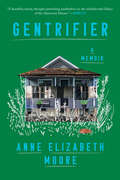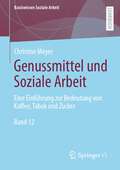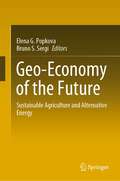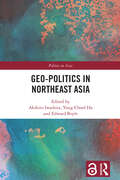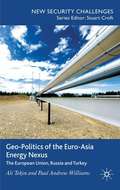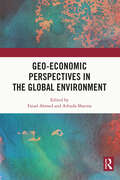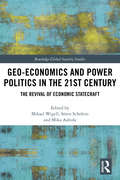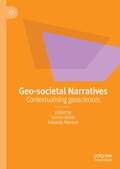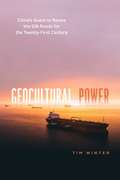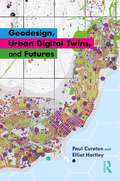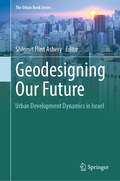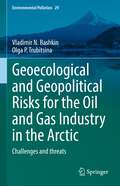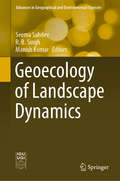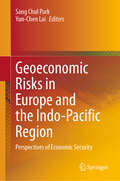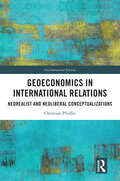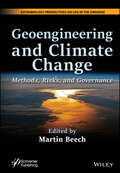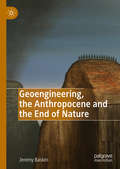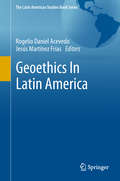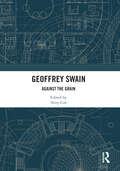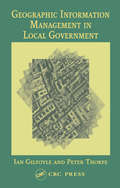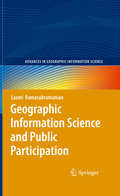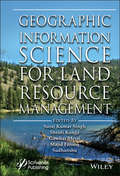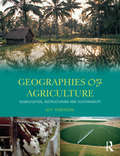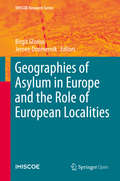- Table View
- List View
Gentrifier
by Peter Marcuse Marc Lamont Hill Jason Patch John Joe SchlichtmanAs urban job prospects change to reflect a more ‘creative’ economy and the desire for a particular form of ‘urban living’ continues to grow, so too does the migration of young people to cities. Gentrification and gentrifiers are often understood as ‘dirty’ words, ideas discussed at a veiled distance.Gentrifiers, in particular, are usually a ‘they.’ Gentrifier demystifies the idea of gentrification by opening a conversation that links the theoretical and the grassroots, spanning the literature of urban sociology, geography, planning, policy, and more. Along with established research, new analytical tools, and contemporary anecdotes, John Joe Schlichtman, Jason Patch, and Marc Lamont Hill place their personal experiences as urbanists, academics, parents, and spouses at the centre of analysis. They expose raw conversations usually reserved for the privacy of people’s intimate social networks in order to complicate our understanding of the individual decisions behind urban living and the displacement of low-income residents. The authors’ accounts of living in New York City, San Diego, Chicago, Philadelphia, and Providence link economic, political, and sociocultural factors to challenge the readers’ current understanding of gentrification and their own roles within their neighbourhoods. A foreword by Peter Marcuse opens the volume.
Gentrifier: A Memoir
by Anne Elizabeth MooreTaking on the thorny ethics of owning and selling property as a white woman in a majority Black city and a majority Bangladeshi neighborhood with both intelligence and humor, this memoir brings a new perspective to a Detroit that finds itself perpetually on the brink of revitalization.In 2016, a Detroit arts organization grants writer and artist Anne Elizabeth Moore a free house—a room of her own, à la Virginia Woolf—in Detroit&’s majority-Bangladeshi &“Banglatown.&” Accompanied by her cats, Moore moves to the bungalow in her new city where she gardens, befriends the neighborhood youth, and grows to intimately understand civic collapse and community solidarity. When the troubled history of her prize house comes to light, Moore finds her life destabilized by the aftershocks of the housing crisis and governmental corruption. This is also a memoir of art, gender, work, and survival. Moore writes into the gaps of Woolf&’s declaration that &“a woman must have money and a room of one&’s own if she is to write&”; what if this woman were queer and living with chronic illness, as Moore is, or a South Asian immigrant, like Moore&’s neighbors? And what if her primary coping mechanism was jokes? Part investigation, part comedy of a vexing city, and part love letter to girlhood, Gentrifier examines capitalism, property ownership, and whiteness, asking if we can ever really win when violence and profit are inextricably linked with victory.
Genussmittel und Soziale Arbeit: Eine Einführung zur Bedeutung von Kaffee, Tabak und Zucker (Basiswissen Soziale Arbeit #12)
by Christine MeyerDas Lehrbuch bietet einen Einstieg in Fragen rund um drei für Soziale Arbeit bedeutende Genussmittel: Kaffee, Tabak und Zucker. Fachkräfte der Sozialen Arbeit sind wiederkehrend in ganz verschiedenen Perspektiven mit ihrem Konsum befasst. Neben gesundheitsbezogenen Fragen aufgrund der gesellschaftlichen Ächtung von (zu viel) Zucker und Tabak lassen sich an ihnen bedeutende sozialpädagogische Fragen aufmachen, die jenseits gesundheitsbezogener, z. B. Fragen der Gastlichkeit, der Gestaltung professionell angenehmer Atmosphären, der Verteilung sowie des offenen Zugangs betreffen. In nahezu jedem sozialpädagogischen Setting werden täglich Verzehrsituationen bzw. Mahlzeiten geplant, angeboten und durchgeführt. Für die Soziale Arbeit über die Bereitstellung ausreichender und ausgewogener Ernährung hinaus verantwortlich ist für die Bereitstellung von Genussmitteln und deren Konsum vor dem Hintergrund gesellschaftlich relevanter eingelebter Kulturen und Traditionen. Das Lehrbuch ermöglicht, über den Gesamtzusammenhang von Genussmitteln im Zusammenhang mit Ernährung als grundlegende und voraussetzungsvolle Bedingungen sozialpädagogischen Denkens und Handelns reflektieren zu können. In allen Handlungsfeldern der Sozialen Arbeit sind Genussmittel auf unterschiedlichen Ebenen und mit verschiedenen Funktionen wiederkehrend Thema und können als täglich zu bewältigende Herausforderung eingeschätzt werden. Diese grundlegende Einführung ermöglicht eine Bewusstmachung und damit auch fachliche Reflexionsmöglichkeiten für den individuellen und gesellschaftlich verantwortlichen sozialpädagogischen Umgang von Fachkräften mit Fragen rund um die insbesondere für Soziale Arbeit bedeutenden Genussmittel Kaffee, Tabak und Zucker.
Geo-Economy of the Future: Sustainable Agriculture and Alternative Energy
by Elena G. Popkova Bruno S. SergiThis book presents an international review of the modern geo-economy and a scientific take on the geo-economy of the future. It identifies the challenges of climate change and their impact on the modern geo-economy. Prospects for the geo-economy of the future are outlined based on sustainable agriculture and alternative energy. Policy implications are put forward to develop a geo-economy of the future in response to the challenges of climate change. The book presents management implications for the development of the geo-economy of the future in response to the challenges of climate change at the regional and global scale. It presents the lessons-learned through the COVID-19 pandemic, and applies experiences of countries with different environmental conditions for agriculture and the development of the energy sector. Based on these results, advanced practical recommendations and ready-made frameworks at the national, regional, and enterprise level are provided.
Geo-Politics in Northeast Asia (Politics in Asia)
by Akihiro Iwashita Yong-Chool Ha Edward BoyleGeo-Politics in Northeast Asia focuses on the dynamics of Northeast Asia as a region. The chapters in this book offer a nuanced approach for understanding the geo-politics of this strategically critical area of the world. Focusing on China, Japan, Russia, and the Koreas, as well as the involvement of the United States, the contributors to the volume offer a timely and critical analysis of Northeast Asia. They collectively emphasize the different scales at which the region holds significance, and particularly note how the region is often granted significance by local political forces as well as national interests. Borderlands and sub-regions are especially important in this perspective, and the contributors show both how regionalism influences the people living in these areas and how they in turn shape the political priorities of states. At the same time, the worsening of relations between Japan and the Koreas and the increasing assertiveness of both China and Russia make it essential to understand the dynamics of the region, as well as how they have changed during and following the Trump era. Geo-Politics in Northeast Asia is essential reading for students and scholars of Political Geography, International Relations and Strategic Studies, as well as for those with a research focus on Northeast Asia, or the wider Asia-Pacific and Indo-Pacific regions.
Geo-Politics of the Euro-Asia Energy Nexus
by Ali Tekin Paul Andrew WilliamsA freshly provocative look at the nexus linking EU security, trans-Turkey energy supply routes to Europe and Turkey's EU membership negotiations, this book argues that Europe's collective energy security prospects have become increasingly tied to Turkey's progress towards joining the EU.
Geo-economic Perspectives in the Global Environment
by Faisal Ahmed Arbuda SharmaThe Covid-19 pandemic brought about significant changes in the world order. It not only reshaped the global geopolitical architecture but also created newer challenges and opportunities for international trade and businesses. This book deliberates on these new global realities through a multidisciplinary perspective. It delves into various key issues pertaining to finance, infrastructure, policy, geostrategy, and entrepreneurship in the Indian context. The volume discusses themes such as geostrategic shifts and their impact on the Indo-Pacific region, the effects of Covid-19 on international and economic security, India-China bilateral ties, FDI spill over on domestic firms, entrepreneurship education in India, and the Thai Canal project. Rich in insights on various geo-economic perspectives that continue to shape the global business environment, the book will be useful for students and scholars of sociology, business management, business economics, international trade, geopolitics, international relations, political sociology, and political studies. It will serve as a useful reference for academics, researchers, think tanks, industry professionals, and policymakers.
Geo-economics and Power Politics in the 21st Century: The Revival of Economic Statecraft (Routledge Global Security Studies)
by Mikael Wigell Sören Scholvin Mika AaltolaStarting from the key concept of geo-economics, this book investigates the new power politics and argues that the changing structural features of the contemporary international system are recasting the strategic imperatives of foreign policy practice. States increasingly practice power politics by economic means. Whether it is about Iran’s nuclear programme or Russia’s annexation of Crimea, Western states prefer economic sanctions to military force. Most rising powers have also become cunning agents of economic statecraft. China, for instance, is using finance, investment and trade as means to gain strategic influence and embed its global rise. Yet the way states use economic power to pursue strategic aims remains an understudied topic in International Political Economy and International Relations. The contributions to this volume assess geo-economics as a form of power politics. They show how power and security are no longer simply coupled to the physical control of territory by military means, but also to commanding and manipulating the economic binds that are decisive in today’s globalised and highly interconnected world. Indeed, as the volume shows, the ability to wield economic power forms an essential means in the foreign policies of major powers. In so doing, the book challenges simplistic accounts of a return to traditional, military-driven geopolitics, while not succumbing to any unfounded idealism based on the supposedly stabilising effects of interdependence on international relations. As such, it advances our understanding of geo-economics as a strategic practice and as an innovative and timely analytical approach. This book will be of much interest to students of security studies, international political economy, foreign policy and International Relations in general.
Geo-societal Narratives: Contextualising geosciences
by Martin Bohle Eduardo MaroneThis book provides an accessible overview of the societal relevance of contemporary geosciences. Engaging various disciplines from humanities and social sciences, the book offers philosophical, cultural, economic, and geoscientific insights into how to contextualise geosciences in the node of Culture and Nature.The authors introduce two perspectives of societal geosciences, both informed by the lens of geoethics. Throughout the text core themes are explored; human agency, the integrity of place, geo-centricity, economy and climate justice, subjective sense-making and spirituality, nationalism, participatory empowerment and leadership in times of anthropogenic global change. The book concludes with a discussion on culture, education, or philosophy of science as aggregating concepts of seemingly disjunct narratives.The diverse intellectual homes of the authors offer a rich resource in terms of how they perceive human agency within the Earth system. Two geoscientific perspectives and fourteen narratives from various cultural, social and political viewpoints contextualise geosciences in the World(s) of the Anthropocene.
Geocultural Power: China's Quest to Revive the Silk Roads for the Twenty-First Century (Silk Roads)
by Tim WinterLaunched in 2013, China's Belt and Road Initiative is forging connections in infrastructure, trade, energy, finance, tourism, and culture across Eurasia and Africa. This extraordinarily ambitious strategy places China at the center of a geography of overland and maritime connectivity stretching across more than sixty countries and incorporating almost two-thirds of the world’s population. But what does it mean to revive the Silk Roads for the twenty-first century? Geocultural Power explores this question by considering how China is couching its strategy for building trade, foreign relations, and energy and political security in an evocative topography of history. Until now Belt and Road has been discussed as a geopolitical and geoeconomic project. This book introduces geocultural power to the analysis of international affairs. Tim Winter highlights how many countries—including Iran, Sri Lanka, Kenya, Malaysia, Indonesia, Pakistan, and others—are revisiting their histories to find points of diplomatic and cultural connection. Through the revived Silk Roads, China becomes the new author of Eurasian history and the architect of the bridge between East and West. In a diplomatic dance of forgetting, episodes of violence, invasion, and bloodshed are left behind for a language of history and heritage that crosses borders in ways that further the trade ambitions of an increasingly networked China-driven economy.
Geodesign, Urban Digital Twins, and Futures
by Paul Cureton Elliot HartleyGeodesign, Urban Digital Twins, and Futures explores systems, processes, and novel technologies for planning, mapping, and designing our built environment. In a period of advancing urban infrastructure, technological autonomy in cities, and high-performance geographic systems, new capabilities, novel techniques, and streamlined procedures have emerged concurrently with climatic challenges, pandemics, and increasing global urbanisation. Chapters cover a range of topics such as urban digital twins, GeoBIM, geodesign and collaborative tools, immersive environments, gamification, and future methods. This book features over 100 international projects and workflows, five detailed case studies, and a companion website. In addition, this book examines geodesign as an agent for collaboration alongside futuring methods for imagining and understanding our future world.The companion website for this book can be accessed at http://geodesigndigitaltwins.com.
Geodesigning Our Future: Urban Development Dynamics in Israel (The Urban Book Series)
by Shlomit Flint AsheryThis book examines how map-based collaboration software can facilitate negotiations in areas undergoing contentious pressures for significant change. Based on case studies from Israel, it aims to introduce a useful model of planning implementation as an outcome of complex interaction to reduce the gap between planning and urban reality. It puts an analytical realist foundation for a productive discussion of the role of future planning and bares meaningful scientific contributions to the general frame of the negotiating process and implementation, which still needs further research and elaboration.Geodesign, a cutting-edge planning approach that is rooted in the history of planning practice, has become one of the most popular approaches for sustainable planning and design activities after 2000s. Planners tend to think of design at a site scale, but geodesign covers a variety of scales, bridging the gap between the regional and the local contexts.This is important because to be practically effective and politically prudent, "smart growth" plans need to make sense across a spectrum of scales and disciplines. This ranges from design, urban design, community planning, town and city planning, and regional planning, up to planning for mega-regions.
Geoecological and Geopolitical Risks for the Oil and Gas Industry in the Arctic: Challenges and threats (Environmental Pollution #29)
by Vladimir N. Bashkin Olga Р. TrubitsinaThis book discusses issues of geoecological (GER) and geopolitical (GPR) risks due to hydrocarbon development of the Arctic. The authors explain the ethical and philosophical foundations of understanding environmental equity and justice in relation to the development of Arctic natural resources and consider various approaches to the moral aspects of making global management decisions in the field of environmental protection and environmental safety. Special attention is paid to analysis of modern geopolitical and geostrategic challenges to the development of the Arctic region. The monograph identifies the key geopolitical factors affecting the sustainable development of the Arctic and analyzes the similarities and differences in the geostrategic positions of the five Arctic states. The authors reveal the need to consider geopolitical challenges in the process of GER analysis for oil and gas development in the Arctic region. The book explores the intersection of the strategic interests for a number of states and describes Russia's inability to ensure environmental safety in the development of Arctic deposits. The book analyzes in detail each type of GER with an emphasis on their potential to lead to additional opportunities and threats, and assesses environmental rating as an indicator of the GER management process of Russian oil and gas companies operating in the Arctic. Although the main focus is on the Russian part of this region, many arguments and conclusions are quite applicable to the entire Arctic region. The consideration of geoecological and geopolitical aspects of the development of Arctic resources with the example of Russian oil and gas companies sheds light on the entire Arctic region, taking into account the interests of all other national and international companies involved in GER and GPR there.
Geoecology of Landscape Dynamics (Advances in Geographical and Environmental Sciences)
by R. B. Singh Manish Kumar Seema SahdevThis book provides an overview of the ecological indicators of landscape dynamics in the context of geographical landscape integration. Landscape dynamics depicts every change that occurs in the physical, biological, and cognitive assets of a landscape. To understand and interpret the complex physical, biological, and cognitive phenomena of landscapes, it is necessary to operate conceptually and practically on a broad range of spatial and temporal scales. Rapid land use changes have become a concern to environmentalists and planners because of their impacts on the natural ecosystem, which further determines socioeconomic dynamics. In this regard, the book discusses case studies that share new insights into how landscape patterns and processes impact small creatures, and how small creatures in turn influence landscape structure and composition. In turn, the relevant aspects of land use and land cover dynamics are covered, and the multi-faceted relationship between the substrata and ecological community is highlighted. The book is unique in its focus on the application of spatial informatics such as automatic building extraction from high-resolution imagery; a soil resource inventory for meeting the challenges of land degradation; hydrological modeling; the temporal variation analysis of glacier area and the identification and mapping of glacial lakes; morphometric analysis of river basins; and the monitoring and modeling of urban sprawl, among other features.
Geoeconomic Risks in Europe and the Indo-Pacific Region: Perspectives of Economic Security
by Sang Chul Park Yun-Chen LaiThis book explores the evolving landscape of global political economy amidst a shifting global order, ushered in by the impacts of the COVID-19 pandemic, geopolitical conflicts in Ukraine and Gaza, and rising trade and political disputes between the US, China and the EU, leading to a rise in protectionist policies and disruptions in global supply chains leading to high inflation, and energy and food crises. Focusing on the relations between the European Union and the Indo-Pacific region, this book examines how recent protectionist policies are reshaping economic security and cooperation between the two actors.
Geoeconomics in International Relations: Neorealist and Neoliberal Conceptualizations (New International Relations)
by Christian PfeifferThis book provides a comprehensive and systematic analysis of the concept of geoeconomics in International Relations (IR). It offers an accessible overview of the most important approaches, including their history, means and ends, methodology, ideological underpinnings, normative aspects, and practical relevance. Exploring the forgotten history of geoeconomics, and revealing its different meanings and usages over time, the author clearly differentiates geoeconomics from geopolitics on a conceptual level. This thorough examination of contemporary conceptions identifies shortcomings in the current understanding of geoeconomics and proposes a reconceptualization of the concept within a neoliberal framework, increasing its empirical usefulness and analytical value. By contrasting neoliberal geoeconomics with neorealist geoeconomics, the book highlights the normative implications of both approaches, providing policy analysts and makers with valuable insights into the topic. This volume will be an important reference guide for understanding the concept of geoeconomics and a must-read for students and researchers of international relations, international political economy, economics, and political science, as well as professionals, such as policymakers and politicians.
Geoengineering and Climate Change: Methods, Risks, and Governance (Astrobiology Perspectives on Life in the Universe)
by Martin BeechThis important and timely book assembles expert scientists from both sides of the debate to discuss Earth-based and space-based climate intervention technologies including the scale, deployment, risk management, and moral philosophy behind these technologies. The role that geoengineering might play, within the context of global warming amelioration, has long been contentious. For all this, geoengineering is about getting down and dirty with respect to the issue of climate intervention. Often dismissed as an option of last resort, geoengineering is now emerging as a key component in humanity’s drive to bring the impacts of global warming under some form of mitigation and control. While geoengineering does not solve the fundamental problem of continued anthropomorphic carbon dioxide emissions, the root cause of global warming, it is an option that can effectively buy humanity some much-needed time. Time, that is, to act positively, and time to introduce meaningful emission reductions, and deploy large-scale sequestration technologies. Indeed, the failure to meaningfully corral greenhouse gas emission levels, and the slow development of large-scale carbon capture technologies, will, by the close of the 21st century, likely see global temperatures increase by at least 2 or 3 degrees above pre-industrial levels. What geoengineering can potentially do for us is to offset the more extreme climate change scenarios that are presently projected to come about. An integrated geoengineering program to cool Earth’s atmosphere, running in parallel with the development of sequestration technologies, and substantial emission reductions, can work to limit the worst effects of climate change that will, without geoengineering, surely come about. Geoengineering is not a neutral or benign action, however, and if it is to be deployed, then much more research, and field testing of ideas and technologies is urgently needed. The authors in this book present a cross-section of philosophies, engineering approaches, and reactions to the idea of geoengineering. Through their words, the reader is introduced to the historical and contemporary debate concerning the potential deployment of geoengineering actions. Indeed, there are many ways in which geoengineering, as a grand worldwide initiative, or as a combined set of independent actions, might proceed in both the near, and the deep future, and here the reader is introduced to these topics by experts in their field. Audience This book will be of interest to engineers, chemists, geologists, physicists, biologists, environmentalists, meteorologists, philosophers, mathematicians, computer modelers, and policy managers. General readers interested in geoengineering will find the book very readable and scientifically reliable.
Geoengineering, the Anthropocene and the End of Nature
by Jeremy BaskinThis book takes a critical look at solar geoengineering as an acceptable means for addressing climate change. Baskin explores the assumptions and imaginaries which animate ‘engineering the climate’ and discusses why this climate solution is so controversial. The book explains geoengineering’s past, its revival in the mid-2000s, and its future prospects including its shadow presence in the Paris climate accord. The main focus however is on dissecting solar geoengineering today – its rationales, underpinning knowledge, relationship to power, and the stance towards nature which accompanies it. Baskin explores three competing imaginaries associated with geoengineering: an Imperial imaginary, an oppositional Un-Natural imaginary, and a conspiratorial Chemtrail imaginary. He seeks to explain why solar geoengineering has struggled to gain approval and why resistance to it persists, despite the support of several powerful actors. He provocatively suggests that reconceptualising our present as the Anthropocene might unwittingly facilitate the normalisation of geoengineering by providing a sustaining socio-technical imaginary. This book is essential reading for those interested in climate policy, political ecology, and science & technology studies.
Geoethics In Latin America (The Latin American Studies Book Series)
by Rogelio Daniel Acevedo Jesús Martínez FríasThis book studies geoethics in Latin America and offers comprehensive research on geoethics and geoeducation. Its respective chapters explore geoethics in relation to UNESCO geoparks, mining activities in Latin America, natural hazards and risk management. Geoethics is a key discipline in the field of Earth and Planetary Sciences, and not only includes scientific, technological, methodological and social-cultural aspects, but also addresses the need to consider appropriate protocols, scientific integrity issues and a code of good practice when studying the abiotic world.The position of Latin America’s recently created geoethics associations is based on protection of the environment, together with a reassurance that the balance of nature and the rights of human beings to enjoy it will be preserved.
Geoffrey Swain: Against the Grain (Routledge Europe-Asia Studies)
by Terry CoxAcclaimed historian, and retired Alec Nove Chair in Russian and East European History at the University of Glasgow, Geoffrey Swain, has written extensively on the history of Russia and Eastern Europe during the twentieth century, in particular on Russia during the Civil War, Latvia during the first years of Soviet rule, and the career of Josip Broz Tito. Esteemed for his pursuit of historical enquiry which went "against the grain" of commonly accepted views of communism in power, significantly, Swain also explored the strength or coherence of some of the alternatives that emerged to the paths actually taken, themes which, in their own way, run through this collection of essays, featuring contributions predominantly from papers delivered at the 7th CRCEES Research Forum in July 2015.Honoring the critical tradition and at times contentious work of Geoffrey Swain, this volume comprises seven original articles offering alternative insights into the complexities of Russian, Yugoslav and Latvian history, which are complemented by three essays reviewing his work, it’s context and implications. This book was originally published as a special issue of Europe-Asia Studies.
Geographic Information Management in Local Government
by Peter Thorpe Ian GilfoyleAs early pioneers in the use of digital geographic data, many local governments in the UK were ahead of their counterparts in central government and the private sector in the application of GIS technology. To meet current challenges, local authorities must coordinate the latest technology with effective information management strategies, human and
Geographic Information Science and Public Participation
by Laxmi RamasubramanianComputer-mediated participation is at the crossroads. In the early heady days of the digital revolution, access to "high" technologies such as GIS promised the empowerment of marginalized communities by providing data and information that was previously hidden away from public view. To a great extent, this goal has been achieved at least in the U.S. and Western Europe - data about a range of government initiatives and raw data about different aspects of spatial planning such as land use, community facilities, property ownership are available a mouse-click away. Now, that we, the public, have access to information, are we able to make better plans for the future of our cities and regions? Are we more inclusive in our planning efforts? Are we able to foster collaborative governance structures mediated by digital technologies? In the book, these issues will be discussed using a three-part structure. The first part of the book will be theoretical - it will review the literature in the field, establish a framework to organize the literature and to link three different subject areas (participation and community development, GIS and other related technologies, and planning processes). The second part of the book will be a series of success stories, case studies that review actual situations where participatory planning using GIS has enabled community wellbeing and empowerment. These case studies will vary in scale and focus on different planning issues (planning broadly defined). The final part of the book will step back to review alternative scenarios for the future, exploring where we are headed, as the technologies we are using to plan rapidly change.
Geographic Information Science for Land Resource Management
by Shruti Kanga Suraj Kumar Singh Gowhar Meraj Majid Farooq SudhanshuGeographic Information Science for Land Resource Management is a comprehensive book focusing on managing land resources using innovative techniques of spatial information sciences and satellite remote sensing. The enormous stress on the land resources over the years due to anthropogenic activities for commercialization and livelihood needs has increased manifold. The only solution to this problem lies in the stakeholders' awareness, which can only be attained through scientific means. The awareness is the basis of the sustainable development concept, which involves optimal management of natural resources, subject to the availability of reliable, accurate, and timely information from the global to local scales. GIScience consists of satellite remote sensing (RS), Geographical Information System (GIS), and Global Positioning System (GPS) technology that is nowadays a backbone of environmental protection, natural resource management, and sustainable development and planning. Being a powerful and proficient tool for mapping, monitoring, modeling, and managing natural resources can help understand the earth's surface and its dynamics at different observational scales. Through the spatial understanding of land resources, policymakers can make prudent decisions to restore and conserve critically endangered resources, such as water bodies, lakes, rivers, air, forests, wildlife, biodiversity, etc. This innovative new volume contains chapters from eminent researchers and experts. The primary focus of this book is to replenish the gap in the available literature on the subject by bringing the concepts, theories, and experiences of the specialists and professionals in this field jointly. The editors have worked hard to get the best literature in this field in a book form to help the students, researchers, and policymakers develop a complete understanding of the land system's vulnerabilities and solutions.
Geographies of Agriculture: Globalisation, Restructuring and Sustainability
by Guy RobinsonAgricultural Geography has changed dramatically in recent decades, reflecting the transformation of the farming industry itself. Geographies of Agriculture embraces these changes, applying ideas and methods from contemporary social science, as it moves beyond farm-based production to address current issues affecting the production and consumption of food and fibre throughout the world. The book places special emphasis on topics that reflect globalisation processes, integration of agriculture into the wider agri-food system, concern with attaining sustainable production systems, and the importance of both government and supra-government policies. Examples are drawn from North America, Western Europe and the developing world. Geographies of Agriculture will appeal especially to Geography students, but should also be of interest to a broader range of students in Sociology, Economics and Development Studies, and anyone interested in agriculture, food production and consumption, and rural development.
Geographies of Asylum in Europe and the Role of European Localities (IMISCOE Research Series)
by Birgit Glorius Jeroen DoomernikThis open access book describes how the numerous arrivals of asylum seekers since 2015 shaped reception and integration processes in Europe. It addresses the structuration of asylum and reception systems, and spaces and places of reception on European, national, regional and local level. It also analyses perceptions and discourses on asylum and refugees, their evolvement and the consequences for policy development. Furthermore, it examines practices and policy developments in the field of refugee reception and integration. The volume shows and explains a variety of refugee reception and integration strategies and practices as specific outcome of multilevel governance processes in Europe. By addressing and contextualizing those multiple experiences of asylum seeker reception, the book is a valuable contribution to the literature on migration and integration, societal development and political culture in Europe.

